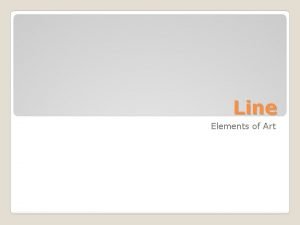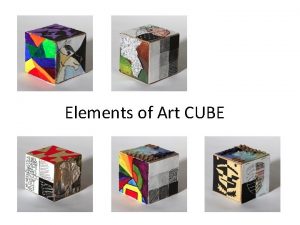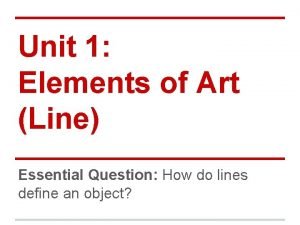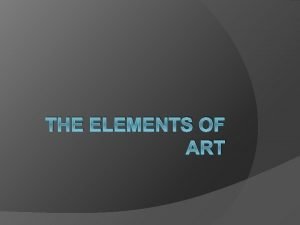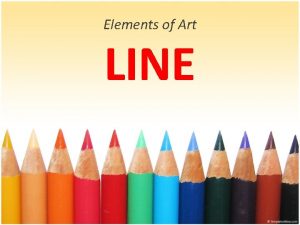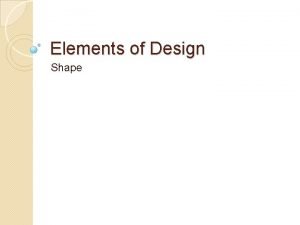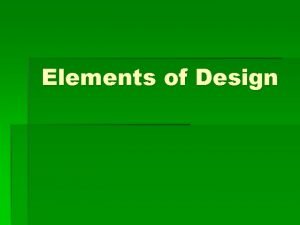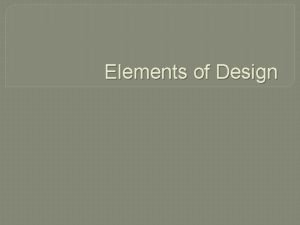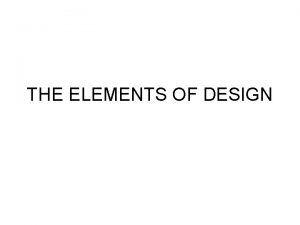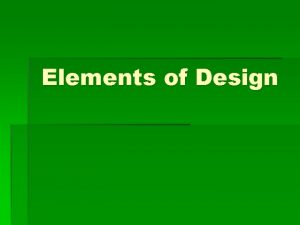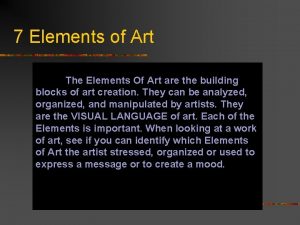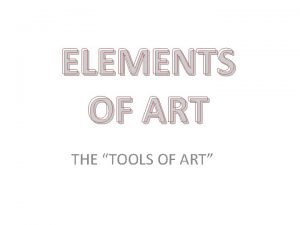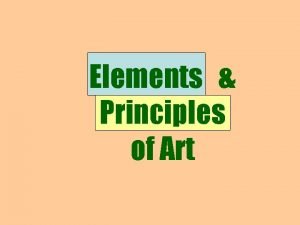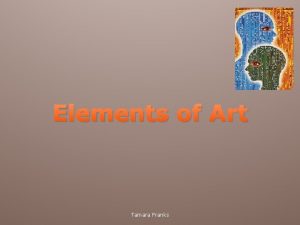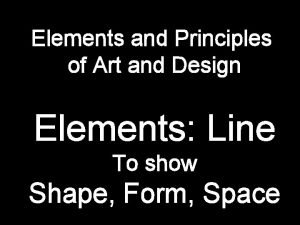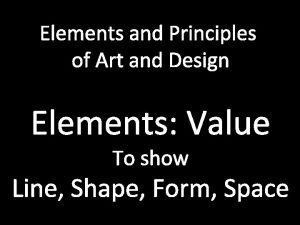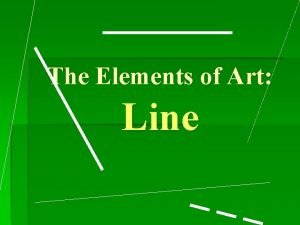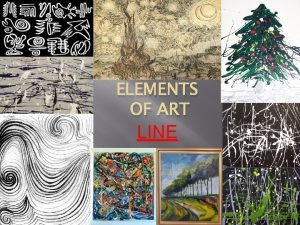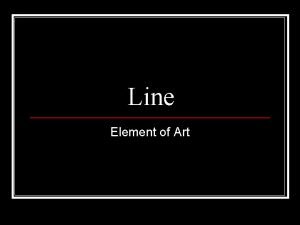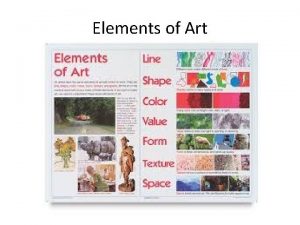The Elements of Art and Design Line Line



























- Slides: 27

The Elements of Art and Design

Line • Line : a continuous mark made on a surface by a moving point. • It is one-dimensional and can vary in width, direction, and length. Lines often define the edges of a form. Lines can be horizontal, vertical, or diagonal, straight or curved, thick or thin.

Horizontal Line • Horizontal lines suggest a feeling of rest or repose because objects parallel to the earth are at rest. • In this landscape, horizontal lines also help give a sense of space. The lines delineate sections of the landscape, which recede into space. Nicolas Poussin French, 1650 - 1651 Oil on canvas

• In the late 1640 s and early 1650 s, at the height of his artistic maturity, Nicolas Poussin turned from historical narrative to landscape painting. Landscape with a Calm does not illustrate a story but rather evokes a mood.

Vertical Lines • Vertical lines often communicate a sense of height because they are perpendicular to the earth, extending upwards toward the sky. • In this church interior, vertical lines suggest spirituality, rising beyond human reach toward the heavens. Pieter Jansz. Saenredam Dutch, November 1634 Pen and brown ink and watercolor, stylus incising throughout; verso rubbed with black chalk for transfer to panel

• Pieter Saenredam, known to his contemporaries as the "first portraitist of architecture, " made this drawing as the second of two preliminary studies of the choir and north ambulatory of Saint Bavo. • Saenredam transformed the life study into this finely tuned, idealized drawing showing the deep vista from one of the side chapels across the nave to another.

Vertical and Horizontal Lines • Communicate stability and solidity. Rectilinear forms with 90 -degree angles are structurally stable. This stability suggests permanence and reliability. Attributed to Adam Weisweiler French, Paris, about 1785 Oak veneered with ebony and pewter;

Diagonal Lines • Diagonal lines convey a feeling of movement. Objects in a diagonal position are unstable. Because they are neither vertical nor horizontal, they are either about to fall or are already in motion. The angles of the ship and the rocks on the shore convey a feeling of movement or speed in this stormy harbor scene. Claude-Joseph Vernet French, Paris, 1767 Oil on canvas

• In a twodimensional composition, diagonal lines can also indicate depth through perspective. These diagonal lines pull the viewer visually into the image. Fifth Avenue Looking South from Thirtieth Street, attributed to Silas A. Holmes, about 1855

• The curve of a line can convey energy. Soft, shallow curves recall the curves of the human body and often have a pleasing quality and a softening effect on the composition Pool, Saint-Cloud, Eugène Atget, 1915– 1919

• Sharply curved or twisted lines can convey turmoil, chaos, and even violence. In this sculpture, the lines of the contorting bodies and the serpent help convey the intensity of the struggle against the snake's stranglehold. Giovanni Battista Foggini Italian, Florence, about 1720 Bronze

Shape • Shape: an enclosed area determined by line, value, texture, space, and/or a combination of these. (Height, Width)

Form • Form is three-dimensional and encloses volume. (Length, Width, Depth)

Geometric Shapes and Forms • Include mathematical, named shapes such as squares, rectangles, circles, cubes, spheres, and cones. Geometric shapes and forms are often man-made. However, many natural forms also have geometric shapes

Organic Shapes and Forms • Organic shapes and forms are typically irregular or asymmetrical. Organic shapes are often found in nature, but man-made shapes can also imitate organic forms.

Space • Space in a work of art refers to a feeling of depth or three dimensions. • It can also refer to the artist's use of the area within the picture plane. • The area around the primary objects in a work of art is known as negative space, while the space occupied by the primary objects is known as positive space.

Positive and Negative Space • The relationship of positive to negative space can greatly affect the impact of a work of art. In this drawing, the man and his shadow occupy the positive space, while the white space surrounding him is the negative space. The disproportionate amount of negative space accentuates the figure's vulnerability and isolation. Francisco José de Goya y Lucientes Spanish, about 1819 - 1823 Brush and india ink wash

Three-Dimensional Space • The perfect illusion of three -dimensional space in a two-dimensional work of art is something that many artists, such as Pieter Saenredam, labored to achieve. The illusion of space is achieved through perspective drawing techniques and shading.

Color • Light reflected off of objects. Color has three main characteristics: hue (red, green, blue, etc. ), value, and intensity (how bright or dull it is).

Value • Value is the range of lightness and darkness within a picture.

Value • Artists use color value to create different moods. • Dark colors in a composition suggest a lack of light, as in a night or interior scene. Dark colors can often convey a sense of mystery or foreboding. • Light colors often describe a light source or light reflected within the composition. In this painting, the dark colors suggest a night or interior scene. The artist used light colors to describe the light created by the candle flame. Gerrit van Honthorst Dutch, about 1620 Oil on canvas

Intensity • Intensity describes the purity or strength of a color. • Bright colors are undiluted and are often associated with positive energy and heightened emotions. • Dull colors have been diluted by mixing with other colors and create a sedate or serious mood. • In this image the artist captured both the seriousness and the joy of the scene with the dull gray stone interior and the bright red drapery Dieric Bouts Flemish, 1450 - 1455 Distemper on linen

Texture • The surface quality of an object that we sense through touch. All objects have a physical texture. Artists can also convey texture visually in two dimensions.

2 D Texture • Artists use color, line, and shading to imply textures. In this painting, the man's robe is painted to simulate silk. The ability to convincingly portray fabric of different types was one of the marks of a great painter during the 17 th century.

3 D Texture • The surface of this writing desk is metallic and hard. The hard surface is functional for an object that would have been used for writing. The smooth surface of the writing desk reflects light, adding sparkle to this piece of furniture.

AP Breadth Section • 12 pieces – no details • Each artwork you complete this quarter should have at least one element of design. • Be prepared to discuss which element you’ve included during class critiques.

Today’s Assignment • Choose three artworks you’ve already made and try to identify as many elements of design in each work as you can. • Put this information in a Word document and print it out. Place it on my desk by the end of class.
 Line shape form color texture space
Line shape form color texture space Coast salish design elements
Coast salish design elements Elements of art line examples
Elements of art line examples Elements of art cube
Elements of art cube Outline vs contour lines
Outline vs contour lines Art elements line
Art elements line Elements of interior design ppt
Elements of interior design ppt Hình ảnh bộ gõ cơ thể búng tay
Hình ảnh bộ gõ cơ thể búng tay Lp html
Lp html Bổ thể
Bổ thể Tỉ lệ cơ thể trẻ em
Tỉ lệ cơ thể trẻ em Gấu đi như thế nào
Gấu đi như thế nào Tư thế worm breton
Tư thế worm breton Bài hát chúa yêu trần thế alleluia
Bài hát chúa yêu trần thế alleluia Các môn thể thao bắt đầu bằng tiếng đua
Các môn thể thao bắt đầu bằng tiếng đua Thế nào là hệ số cao nhất
Thế nào là hệ số cao nhất Các châu lục và đại dương trên thế giới
Các châu lục và đại dương trên thế giới Công của trọng lực
Công của trọng lực Trời xanh đây là của chúng ta thể thơ
Trời xanh đây là của chúng ta thể thơ Cách giải mật thư tọa độ
Cách giải mật thư tọa độ Phép trừ bù
Phép trừ bù Phản ứng thế ankan
Phản ứng thế ankan Các châu lục và đại dương trên thế giới
Các châu lục và đại dương trên thế giới Thơ thất ngôn tứ tuyệt đường luật
Thơ thất ngôn tứ tuyệt đường luật Quá trình desamine hóa có thể tạo ra
Quá trình desamine hóa có thể tạo ra Một số thể thơ truyền thống
Một số thể thơ truyền thống Cái miệng xinh xinh thế chỉ nói điều hay thôi
Cái miệng xinh xinh thế chỉ nói điều hay thôi Vẽ hình chiếu vuông góc của vật thể sau
Vẽ hình chiếu vuông góc của vật thể sau


